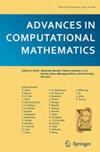非 Lipschitz 随机微分方程的截断 Euler-Maruyama 方法的改进
IF 1.7
3区 数学
Q2 MATHEMATICS, APPLIED
引用次数: 0
摘要
本文关注具有非 Lipschitz 漂移或扩散系数的随机微分方程的数值近似。本文提出了一种改进的截断欧拉-马鲁山离散化方案。此外,通过建立截断式 Euler-Maruyama 方法的随机 C 稳定性和 B 一致性准则,我们得到了数值方法的强收敛性和收敛速率。最后,我们给出了数值示例来说明我们的理论结果。本文章由计算机程序翻译,如有差异,请以英文原文为准。
The improvement of the truncated Euler-Maruyama method for non-Lipschitz stochastic differential equations
This paper is concerned with the numerical approximations for stochastic differential equations with non-Lipschitz drift or diffusion coefficients. A modified truncated Euler-Maruyama discretization scheme is developed. Moreover, by establishing the criteria on stochastic C-stability and B-consistency of the truncated Euler-Maruyama method, we obtain the strong convergence and the convergence rate of the numerical method. Finally, numerical examples are given to illustrate our theoretical results.
求助全文
通过发布文献求助,成功后即可免费获取论文全文。
去求助
来源期刊
CiteScore
3.00
自引率
5.90%
发文量
68
审稿时长
3 months
期刊介绍:
Advances in Computational Mathematics publishes high quality, accessible and original articles at the forefront of computational and applied mathematics, with a clear potential for impact across the sciences. The journal emphasizes three core areas: approximation theory and computational geometry; numerical analysis, modelling and simulation; imaging, signal processing and data analysis.
This journal welcomes papers that are accessible to a broad audience in the mathematical sciences and that show either an advance in computational methodology or a novel scientific application area, or both. Methods papers should rely on rigorous analysis and/or convincing numerical studies.

 求助内容:
求助内容: 应助结果提醒方式:
应助结果提醒方式:


